Obtaining traffic from Google means that you’ve got to keep up with all of Google’s features all of the time.
If you haven’t noticed, Google constantly changes their features.
And you’ve got to know exactly how they work so that you can rank for them.
You also have to keep an eye on competitors.
Google results are now full of so much more than just plain links. Featured snippets are the first thing that most people see when searching for a word or phrase.
They’re also becoming more and more popular each year. Just look at how many posts had featured snippets in 2016 compared to 2014:
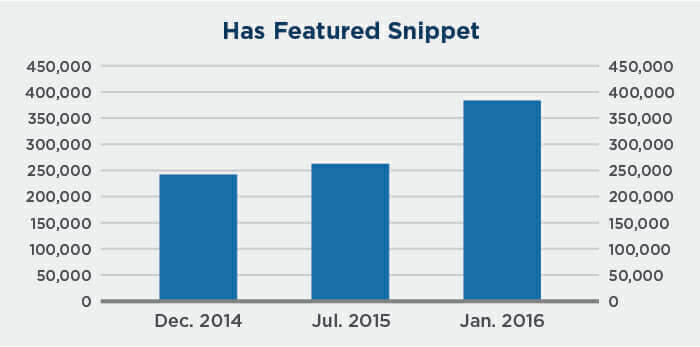
It’s a huge difference, right? But why are they so popular?
It’s because they give answers to the questions people are searching for in a way that’s convenient, quick, and easy to read. You don’t have to click through anything to find what you’re looking for.
They aren’t just helpful for the average person though. Featured snippets give marketers a chance to beat competitors, boost conversions, and drive traffic right to their site.
HubSpot research has shown that content with a featured snippet gets a 2X higher click-through rate.
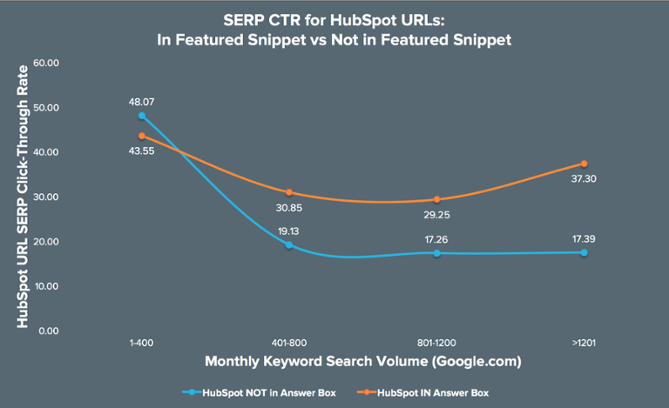
Those results are huge.
But what exactly are Google featured snippets? And how can you optimize your content to rank for them?
What is a Google featured snippet?
Whether you know it or not, you’ve probably seen countless featured snippets from Google when searching for information or answers to your questions.
We often refer to the position that featured snippets give to content as “position zero.”
This is because featured snippets take up the most space on a search results page. They’re usually at the very top of the page, too.
For instance, say that you’re searching for “How to lay tile.”
Google will answer your question with a snippet containing information about your question above all of the other links on the search results.
Google usually pulls them right from the content that’s already ranking on page one, but it can also pull from lower ranking SERPs.
These featured snippets make finding answers easier than ever before because you don’t have to click anything to view the information.
Here’s an example of what featured snippets look like:
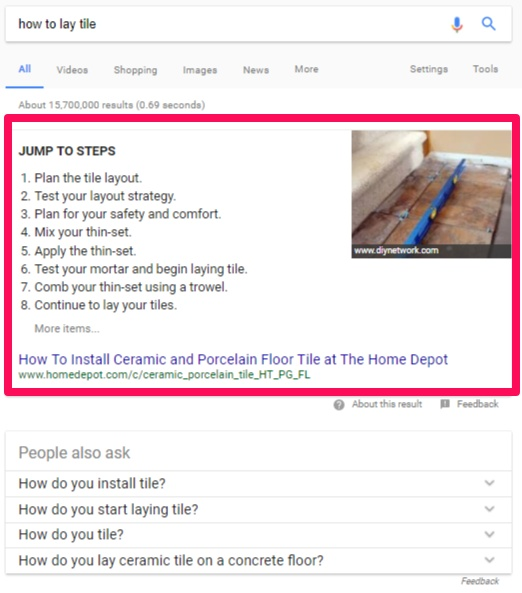
They can contain numbered lists, bullet points, and more. They can answer your search questions with a brief paragraph, too.

Ranking for a featured snippet is so much more helpful and effective for driving visitors to your site than ranking for #1.
Just look at how much space a featured snippet takes up!
They dominate the SERPs, give you tons of exposure, and keep your website far above the fold. Plus, they’ll boost your company’s credibility quicker than any other method.
And you don’t necessarily have to pay any extra advertising fees to rank for them.
You don’t have to be number one in your industry, either.
Any company, regardless of its size or budget, can earn a spot at position zero if they play their cards right.
But there’s no exact formula for earning a featured snippet. And if you earn a position zero spot, it might not last forever if Google decides that another page is better suited to rank for it.
The easiest way to earn a featured snippet spot is to produce quality content and format it in a way that Google will love.
You have to make your content “snippable” so that Google will recognize your link. If you’ve already got some links with high rankings, you’re in luck.
According to Ahrefs, 99.58% of featured snippet pages already rank in the top 10 SERPs in Google for a particular search query.
That’s why you’ve got a good chance of earning featured snippets for search queries that you’ve already achieved high ranking spots with.
However, Getstat says that 70% of snippets come from sites that aren’t in the top-ranking organic position.
So if you aren’t ranking high, don’t worry. You’ve still got a chance to rank for featured snippets.
If your brand focuses on DIY, health, or finance, your chances of getting featured are higher than if you publish content in other industries.
An Ahrefs study found that search queries with the following words have a better chance of getting featured:
- Recipe
- Best
- Vs.
- Make
- Definition
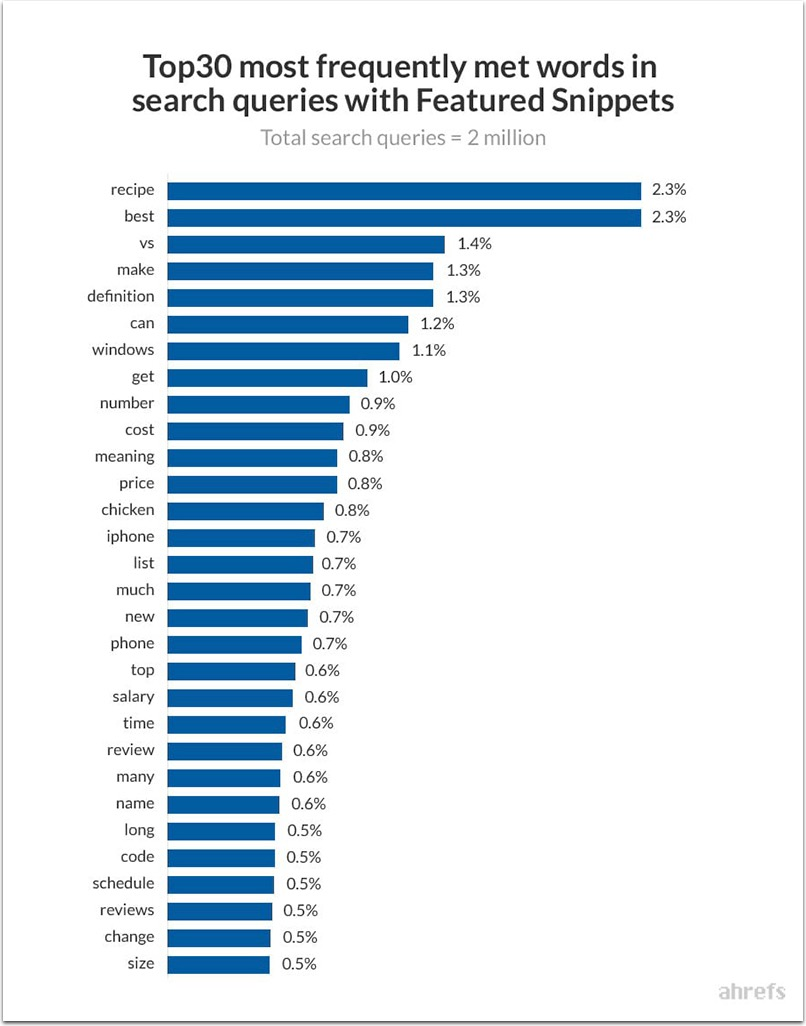
Now let’s go over the different types of featured snippets.
Types of featured snippets
There are three major types of featured snippets:
- Paragraph
- List
- Table
When it comes to paragraph style featured snippets, Google gives an answer to the searcher in text rather than a list. There may also be an image that accompanies the text, like this:

List style featured snippets show an answer in list format. Here’s what list snippets look like:
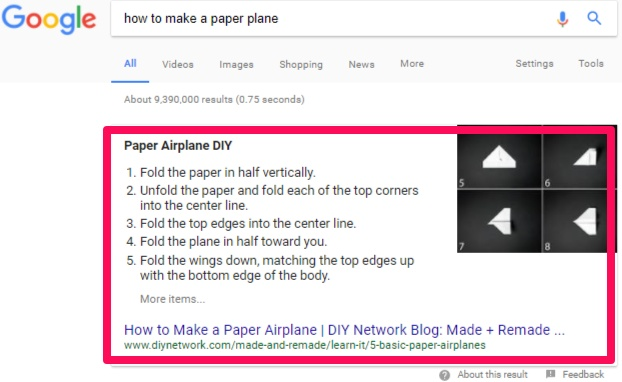
Table snippets provide answers in the form of — you guessed it — tables. They usually look something like this:
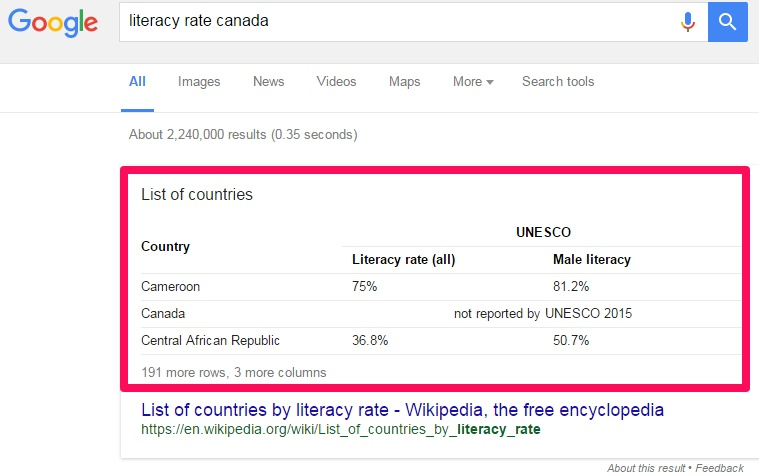
According to Getstat, the most popular type of featured snippet is the “paragraph” type.

The first thing you should do when trying to rank for Google’s featured snippets is to determine which featured snippets your competitors are ranking for.
Tip #1: Use SEMrush to find competitors’ snippets
SEMrush is a great analytics resource, but did you know that you can also use the tool to find featured snippets?
You can use it to find out which featured snippets your competitors have earned as well as find out which featured snippets you’re already ranking for.
All you’ve got to do is run a regular domain search and click “Organic Research.”
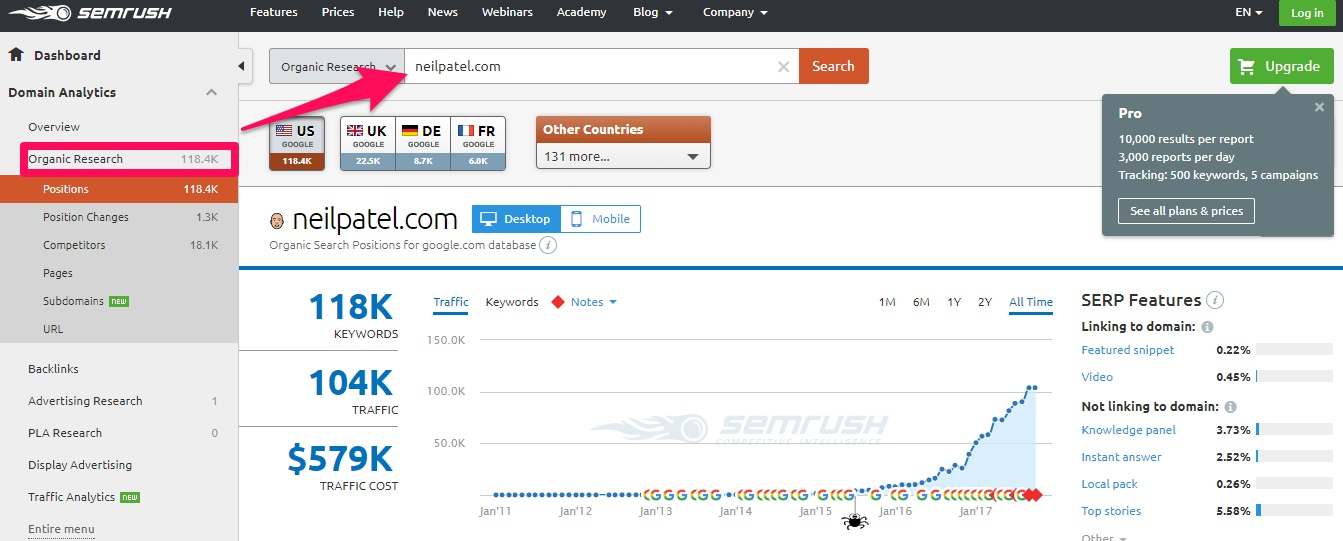
Then, just click on the “Featured Snippet” on the bottom right-hand side of the page.
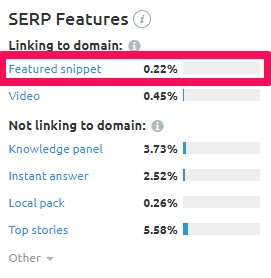
You can even filter keywords by clicking on the “Advanced Filters” option to include featured snippets.
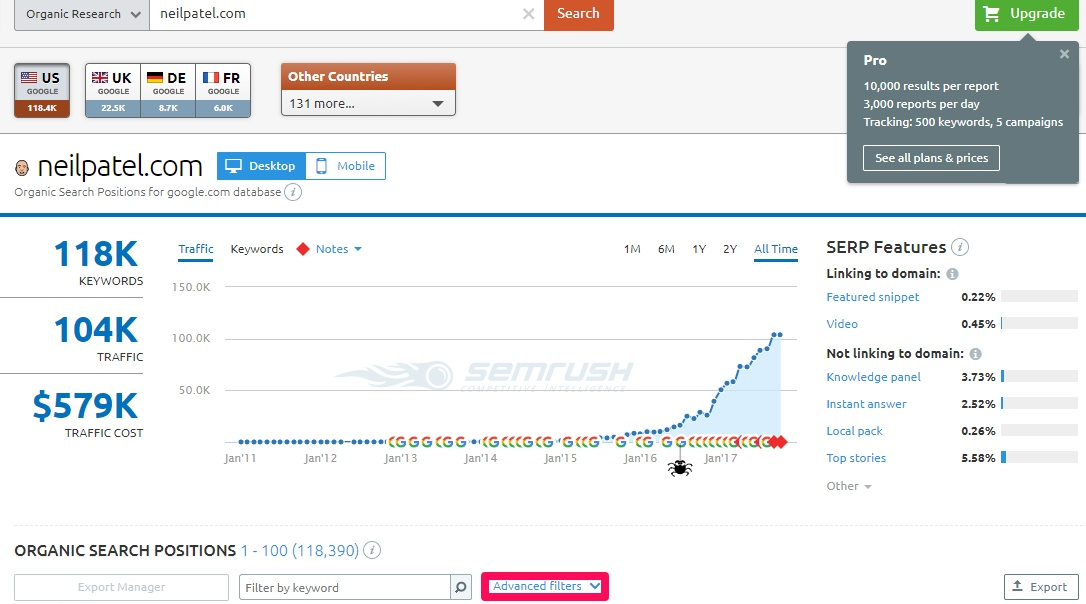
Then, once you know which snippets your competitors are earning, you can optimize your content for the same exact words and topics.
When checking out your own snippets, be sure to keep an eye out for variations of other keywords that you could rank for as well.
But SEMrush isn’t the only resource for finding featured snippets. Google is a great resource, too.
Tip #2: Use Google to uncover snippet opportunities
One of the best ways to find snippets that you can optimize content for is to think like your audience.
What questions are people actually trying to find answers for?
For instance, put yourself in the shoes of someone who is new to marketing and may not understand some common terms.
There are a whole lot of terms and acronyms in the marketing world that can be intimidating and confusing to people who aren’t familiar with them.
Do a short search, such as “What is a CTA in marketing?”
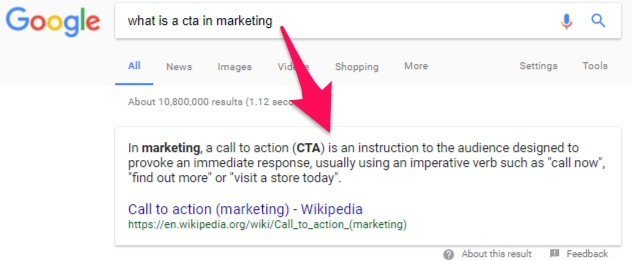
For this search query, there’s a featured snippet in the form of a paragraph.
For the term you look for, the snippet might contain a list or a series of steps. And who knows — the featured content might already be yours.
If it isn’t, check out ideas under the “People also ask” section.
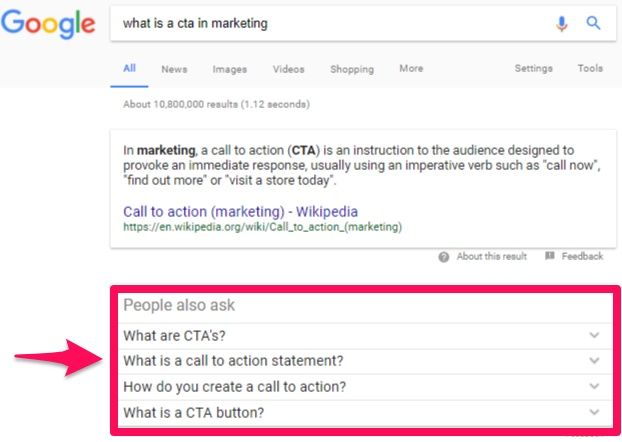
These are questions related to the search you already entered. To look at snippets for each search query, just expand the phrase by clicking the arrows on the right.
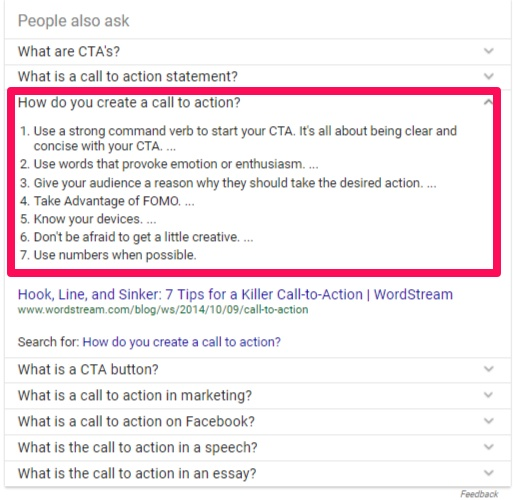
Then, you can read through the full snippet for each related question.
This is a quick way to identify competitors and content ideas in one easy step. Now, you can steal their snippet with a bit of time and effort.
You can also identify some questions by using a site like Answer the Public.
Tip #3: Find content ideas on Answer the Public
Since questions are most likely to bring up featured snippets, you’ve got to answer how, what, when, where, why, or who.
The best place to find out the types of questions people might be asking about a particular topic is Answer the Public.
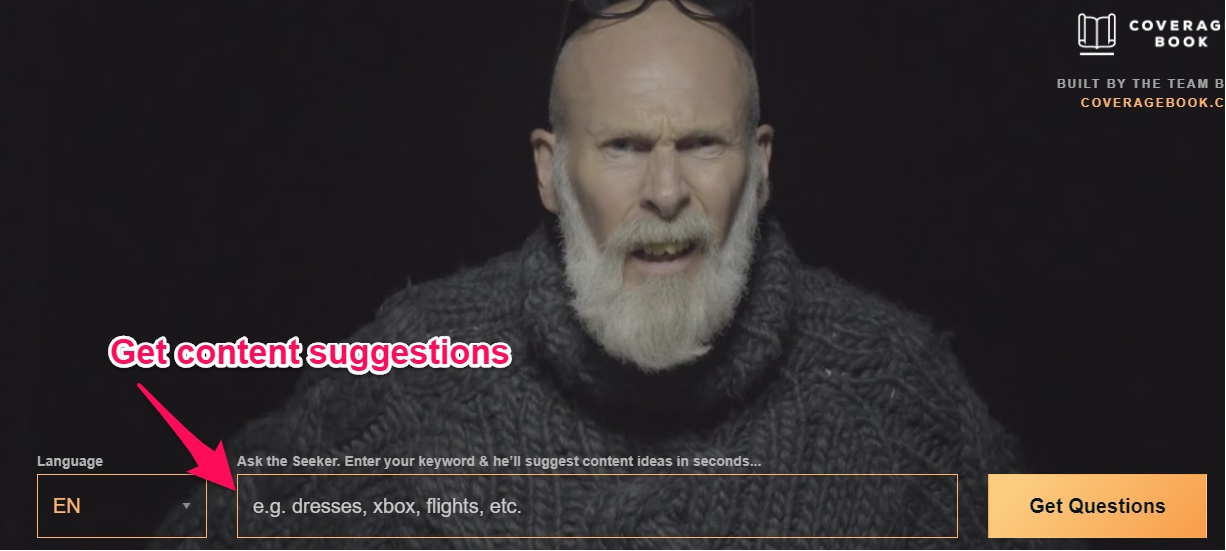
Let’s say you want to learn more about apple pie.
Just type it in and you’ll receive tons of suggestions for questions related to the topic that you can answer with your content.
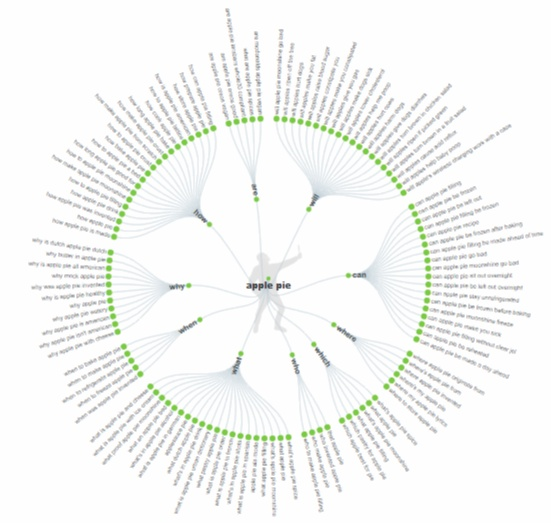
Then, pick which angle you want to take. If you want to answer questions that address the “what,” just focus on that section.

Then, pick a question to answer from that group. It’s that simple!
Keep in mind that you may want to do some keyword research before you do this to make sure the words you’re searching are SEO friendly.
Tip #4: Do keyword research
It’s time for some good old keyword research.
You should already be doing it. But you can optimize your keyword research to help you get featured snippets, too.
It’s a good idea to use a tool or two to find out if a search query will bring up featured results or not.
I like Serpstat because it allows me to easily see which keywords bring up featured snippets on the results page.
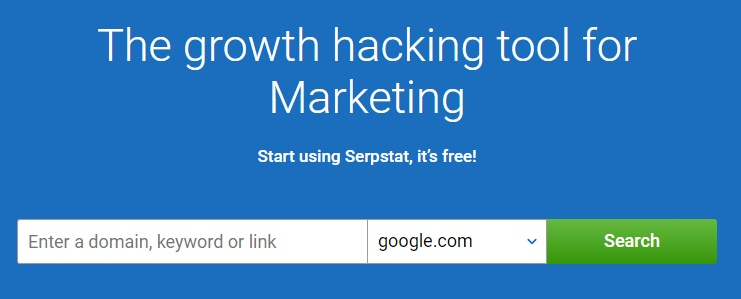
Now that’s pretty neat, right?
Just type in a domain, keyword, or link, and hover over each result to see if featured snippets come up for each.
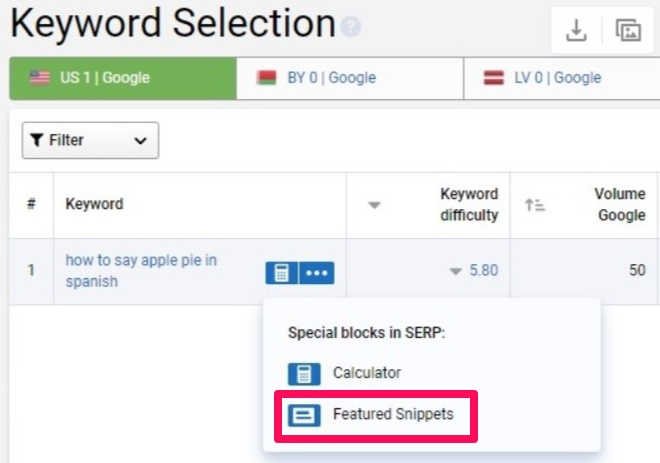
This is awesome for uncovering which featured snippets your competitors are currently ranking for.
Plus, if you already rank high for a particular keyword, it’s worth finding out if Google currently brings up featured snippets for those keywords.
If they do, try to rank for it by identifying (and answering) the questions that people have about that topic.
Then, just format your content to include tags that relate to those questions.
It’s also important to answer more than one question in each of your articles.
Tip #5: Answer multiple questions
Do you remember the Ahrefs study from earlier?
Well, it also uncovered that once a page earns a featured snippet, it’s more likely to become featured in other related queries.
That’s why you should structure your article in a way that answers every related question in one location.

Focus on beefing up one solid article that answers tons of questions rather than multiple articles if you want to earn featured snippets.
Word count is a huge factor to consider, too.
Tip #6: Stay within the optimal word count
Keep your section tight and concise so that Google can easily feature your content.
Section off your lists, paragraphs, and steps rather than letting them all run together.
Just look at this list — it’s only 52 words long!
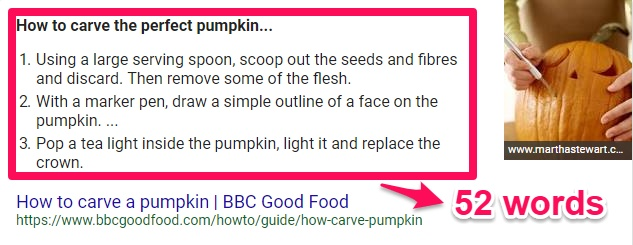
According to SEMrush, this is a pretty normal length for a featured snippet. Their analysis found that “[t]he most common length of content in featured snippets is between 40-50 words.”

Because of this, you should try and keep each section of content no longer than 50 words and no shorter than 40.
Use headers to break up your content sections.
Tip #7: Use headers
One quick, simple way to format your content for featured snippets is to make sure that you break up each section.
Use the “Paragraph styles” section on Google Docs or in WordPress to do this.

Organize your steps, lists, or paragraphs with headers. I prefer h2 headers, myself. Use h1, h2, h3, or h4, and be sure to organize your subheadings by size.
For example, a subheading under a main heading that is h3 should be h4, not h2.
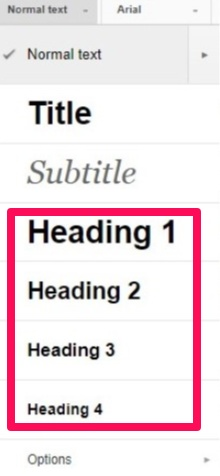
If you add “Step 1, Step 2” or “Rule 1, Rule 2” to each heading phrase, Google will place them in chronological order.
So be sure to format your article in chronological order, too, so that Google will be more likely to feature it.
Another great tip is to add a whole new area to your site devoted to providing resources to your readers and customers.
Tip #8: Add a “how-to” section to your website
Since featured snippets are such a great opportunity to attract website traffic and gain new leads, it’s a smart idea to redesign your site in a way that lets you optimize “how-to” content.
Some websites are creating entire sections on their sites that are specifically for giving answers to their readers’ questions.
Here’s how Lowe’s is doing it with their “How-to Library:”

This gives all of your content that is devoted to answering questions or solving pain points a place to live on your site.
If you don’t want to create a “how-to” section, a Q&A area might be a good idea instead.
This area could include answers to frequently asked questions about your products, services, or industry.
High-quality images and videos also boost your chances of ranking for featured snippets.
Tip #9: Add high-quality images and video
Most people love to learn visually, which is why photos and videos can help you rank for featured snippets.
Adding images to each step doesn’t have to be hard. I have repeatedly said that Canva is a great tool for creating your own images because it truly is.

Upload your own images or pick a free Canva stock photo. Then, choose free shapes, icons, and more to add to your images.

Don’t forget about video either. It’s huge for engagement.
65% of people watch at least three-quarters of a video and 59% of executives believe that people are more likely to watch a video if they combine text with video.
One simple way to do this is to create a voice transcript for all of your videos. Google will recognize the text and might choose it for a featured snippet.
You should also make sure that your video content is high quality.
I try to add transcripts for almost all of my videos, like this one:


I write the entire voice transcript in the description area of the video, right under my other social links.


This allows me to combine my video efforts and my SEO and keyword research plans, optimizing my videos for featured snippets, too.
Conclusion
Trying to keep up with Google can be absolutely exhausting.
But it looks like featured snippets aren’t going anywhere. In fact, they’re on the rise. That means that pages with featured snippets are dominating search queries.
They’re the first thing that comes up in most SERPs and they’re more than just plain links.
Earning a featured snippet means that you rank for position zero, which is the highest ranking spot possible without advertising.
If you want to boost conversions, drive visitors to your website, and beat your competition easily, ranking for featured snippets is the answer.
Now that you know exactly what featured snippets are, there’s no excuse not to try and rank for them.
Start out by finding out which featured snippets your competitors rank for with a tool like SEMrush. You can also use Google to find other featured snippet opportunities.
Use Answer The Public to identify tons of potential content ideas, and be sure to answer as many related questions as possible in one article.
Keep the word count for each question brief: no more than 50 words. Use headers to break up steps and lists, too.
Don’t forget to add a “how-to” or Q&A area to your website to give content that you optimize for featured snippets a place to live.
And add lots of high-quality images and videos where you can. Create voice transcripts for videos so that Google will recognize the text and consider your videos for snippets, too.
Source: Neil Patel




